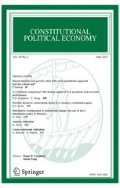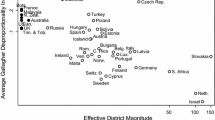Abstract
Here is a full statement of the theory of political parties as long coalitions, ones organized and elected to stick together on all or most legislative votes. The incentive to form, join, and elect them comes from the external cost of simple-majority voting—the central problem of The Calculus of Consent—but more fundamentally from the Paradox of Voting, or cycles of majority preference. I prove that a cycle among prospective legislative outcomes is sufficient for that incentive to be effective, and necessary too: without cycles there would be no parties. The identification of parties with long coalitions originated in a squib written years ago. The chief innovation of this paper is the proven cyclic basis of parties (and with it the absence of parties from one-dimensional voting bodies). Other innovations include extensions of the theory to minority parties, electoral parties, and subnational parties, a deeper explanation than Duvergers’ of two-party systems, and an explanation of how parties maintain their length and use it to prevent defection.
Similar content being viewed by others
Notes
If n voters are divided into three minorities (always possible if 4 ≠ n ≥ 3), one of which prefers x to y to z, another y to z to x, and the third z to x to y, then majorities prefer x to y, y to z, and z to x. This paradox is often confused with Arrow’s, which says nothing whatever about cycles. I must add that cycles based on majority rule and other regimes are common facts of life, not problems to be solved, anomalies to be assumed away, or misfortunes to be avoided or regretted (whereof see Schwartz 2018).
Riker and Brams (1973) show in effect that a, b, and c might themselves be vote-trade packages rather than single bills. E.g., let a = a1 + a2 where a1 yields payoffs 2.5, − 1.5, − 1.5 and a2 yields − 1.5, 2.5, − 1.5, and let Rep. 1 vote for a2 in return for 2′s vote for a1. Those authors attribute the Pareto inefficiency to vote trading, but as we saw, vote trading can also block it.
The equation of parties with long coalitions originated in the unpublished “Why Parties?” of Schwartz (1989). Aldrich (1995) took it up in his monumental work of the same name (borrowed with permission) on U.S. parties. Others have likewise shown how legislative parties might arise endogenously (Baron 1993, Equia 2011, Levy 2004), but they make highly restrictive modeling assumptions. My only one is separability, whereof see Sect. 2 below. Also I now include minority, electoral, and subnational parties.
Bawn et al. (2012) fancy that single parties are themselves coalitions of single-issue interest groups. That is compatible with my theory, but I have lived a long time, part of it as a party activist, and have never met a single-issue partisan. Have you?
To fit the Sect. 1 examples to this new format, let q = (\(\overline{{m_{1} }}\),\(\overline{{m_{2} }}\), \(\overline{{m_{3} }}\)), a = (m1,\(\overline{{m_{2} }}\), \(\overline{{m_{3} }}\)), ab = (m1, m2, \(\overline{{m_{3} }}\)), etc.
The underlying insight is that a majority composed of minorities would produce an unstable outcome, one dispreferred to another by some majority. This was sketched by Downs (1957: 55–69) and proved by Kadane (1972), but neither connected it to cycles or vote trading, much less parties. Bernholz’s (1973) theorem was generalized by Bernholz (1974) and further by Schwartz (1977).
Scholars differ over the need for agenda control to maintain majority-party length (as I would put it) in the U.S. Congress. Krehbiel (1993, 1998) contends that there always is enough agreement within the majority party to make agenda control unnecessary, Aldrich et al. (2001) that there is not always enough to make it possible, Cox and McCubbins (2005) that it is almost always possible and profitable (I agree) but for an implausible reason: to protect the party’s brand at election time. I would instead put the horse before the cart: absent some other reason, a legislative one, to form a long coalition to begin with—already a good enough reason to control the agenda—there would be no party with a brand to protect and no incentive to create one.
Snyder and Groseclose (2000) find that majority-party U.S. congressmen vote surprisingly often with their constituents against their party, but almost never when their party needs their vote. Patterson and Schwartz (2019) find that a majority party sometimes deliberately sets the agenda to “roll” itself, to pass bills opposed on the floor by a majority of its own members.
Assuming sincere voting, no ties, no individual indifference, and no reconsideration, Schwartz (2011) proves that almost every possible history of legislative votes is compatible with cycles but also with their absence, and almost every possible history is incompatible with single peakedness, or one-dimensionality. Then there are the instability and cycle results of Note 7. Contrary to a prevalent fallacy, moreover, neither would the revelation of a single dimension a’ la Poole and Rosenthal (1997) ensure a single dimension of the relevant sort—single peakedness (Schwartz 2018, Section 2.8). I must add that Poole and Rosenthal use their method to show, in effect, how long (in my sense) U.S. parties have been.
References
Aldrich, J. H. (1995). Why parties? The origin and transformation of party politics in America. Chicago: University of Chicago Press.
Aldrich, J. H., & Rohde, D. W. (2001). The logic of conditional party government. In L. C. Dodd & B. I. Oppenheimer (Eds.), Congress reconsidered (7th ed., pp. 269–292). Washington, DC: Congressional Quarterly Press.
Axelrod, R. (1984). The evolution of cooperation. New York: Basic Books.
Balinski, M. L., & Peyton Young, H. (1982). Fair representation. New Haven: Yale.
Baron, D. (1993). Government formation and endogenous parties. American Political Science Review, 85, 137–164.
Bawn, K., Cohen, M., Karol, D., Masket, S., Noel, H., & Zaller, J. (2012). A theory of political parties: groups, policy demands and nominations in American politics. Perspectives on Politics, 10, 571–597.
Bernholz, P. (1973). Log-rolling, arrow-paradox and cyclical majorities. Public Choice, 15, 87–102.
Bernholz, P. (1974). Logrolling, arrow paradox and decision rules: A generalization. Kyklos, 27, 49–61.
Black, D. (1948). On the rational of group decision-making. Journal of Political Economy, 56, 23–24.
Buchanan, J. M., & Tullock, G. (1962). The calculus of consent. Ann Arbor: University of Michigan Press.
Condorcet, M. D. (1785). Essai sur l’Application de l’Analyse a’ la Probabilite’ des Decisions Rendues a’ la Pluralite’ des Voix. Paris.
Cox, G., & McCubbins, M. (2005). Setting the agenda. Cambridge: Cambridge University Press.
Downs, A. (1957). An economic theory of democracy. New York: Harper and Row.
Downs, A. (1961). Problems of majority voting: In defense of majority voting. Journal of Political Economy, 69, 192–199.
Duvergers, M. (1959). Political parties. New York: Wile.
Equia, J. X. (2011). Endogenous parties in an assembly. American Journal of Political Science, 51, 16–26.
Filippov, M., Ordeshook, P. C., & Shvetsova, O. (2004). Designing federalism: A theory of self-sustaining federal institutions. New York: Cambridge University Press.
Kadane, J.B. (1972). On Division of the Question. Public Choice, 13, 47–54.
Krehbiel, K. (1993). Where's the Party? British Journal of Political Science, 23, 235–266.
Krehbiel, K. (1998). Pivotal Politics. Chicago: University of Chicago Press.
Levy, G. (2004). A model of political parties. Journal of Economic Theory, 115, 250–277.
Lijphart, A. (1990). The political consequences of election laws. American Political Science Review, 84, 161–188.
Patterson, S., Jr., & Schwartz, T. (2019). Parties,agendas, and roll rates. Journal of Theoretical Politics, 32, 348–359.
Poole, K., & Rosenthal, H. (1997). Congress. Oxford: Oxford University Press.
Ranney, A. (1975). Curing the mischief of faction: Party reform in America. Berkley: University of California Press.
Rae, D. W. (1967). The political consequences of electoral laws. New Haven: Yale University Press. ((rev. 1971)).
Riker, W. H. (1964). Federalism: Origin, operation, significance. New York: Little, Brown.
Riker, W. H., & Brams, S. (1973). The paradox of vote trading. American. Political Science Review, 67, 1235–1247.
Schattschneider, E. E. (1942). Party government. New York: Rhinehart.
Schwartz, T. (1977). Collective choice, separation of issues, and vote trading. American Political Science Review, 71, 999–1010.
Schwartz, T. (1989). Why parties? UCLA: MS.
Schwartz, T. (2011). One-dimensionality and stability in legislative voting. Public Choice, 148, 197–214.
Schwartz, T. (2018). Cycles and social choice: The true and unabridged story of a most protean paradox. Cambridge: Cambridge University Press.
Snyder, J., & Groseclose, T. (2000). Estimating party influence in congressional roll-call voting. American Journal of Political Science, 44, 193–211.
Taagepera, R., & Shugart, M. S. (1989). Seats and votes: The effects and determinants of electoral systems. New Haven: Yale.
Tullock, G. (1959). Problems of majority voting. Journal of Political Economy, 67, 571–579.
Funding
Not applicable.
Author information
Authors and Affiliations
Corresponding author
Ethics declarations
Conflict of interest
The authors declare that they have no conflict of interest.
Additional information
Publisher's Note
Springer Nature remains neutral with regard to jurisdictional claims in published maps and institutional affiliations.




